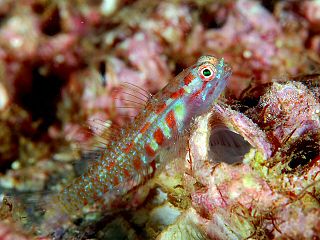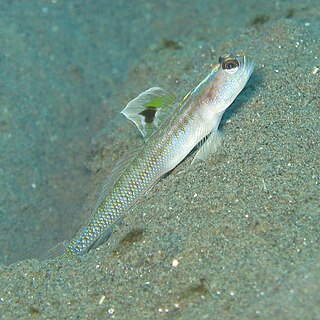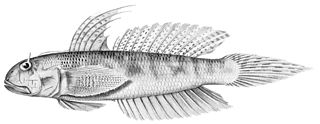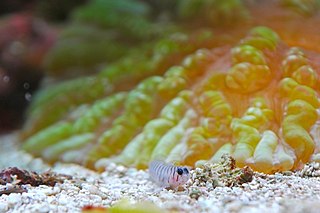
Gymnothorax is a genus of fish in the family Muraenidae found in Atlantic, Indian, and Pacific Oceans. With more than 120 species, it the most speciose genus of moray eels.

Apogon is a large genus of fish in the family Apogonidae, the cardinalfishes. They are among the most common fish on coral reefs. Over 200 species have been classified in genus Apogon as members of several subgenera. Some of these subgenera, such as Ostorhinchus, have been elevated to genus status, leaving just over 50 species in the genus.

Eviota is a genus of fish in the family Gobiidae, commonly as dwarfgobies found in the Indo-Pacific region, where it is distributed from Japan to Australia and from Africa to Pitcairn Island. Species are mainly associated with coral reefs. Many of these fish are short-lived, with life cycles as brief as 3.5 weeks in the tropics. Some species are hermaphrodites and some representatives live symbiotically among the tentacles of the mushroom coral.

Priolepis is a genus of fish in the family Gobiidae with a cosmopolitan distribution.

Elacatinus is a genus of small marine gobies, often known collectively as the neon gobies. Although only one species, E. oceanops, is technically the "neon goby", because of their similar appearance, other members of the genus are generally labeled neon gobies, as well. Except for a single East Pacific species, all reside in warmer parts of the West Atlantic, including the Caribbean and Gulf of Mexico. They are known for engaging in symbiosis with other marine creatures by providing them cleaning service that consists of getting rid of ectoparasites on their bodies. In return, Elacatinus species obtain their primary source of food, ectoparasites.

Vanderhorstia is a genus of gobies native to the Indian and Pacific oceans. The name of this genus honours the Dutch biologist Cornelius van der Horst (1889-1951) of the University of the Witwatersrand, Johannesburg, who was well known for his interest in marine biology.

Starksia is a genus of labrisomid blennies native to the western Atlantic Ocean and the eastern Pacific Ocean. Their typical length is 2 cm (0.79 in) SL. The generic name honours the American ichthyologist Edwin Chapin Starks (1867-1932) of Stanford University for his work on Pacific coastal fishes. As a genus Starksia is distinguished from other labrisomids by their scaled bodies, two obvious soft rays in the pelvic fin and the male's have an intromittent organ which is near to or attached to the first spine of their anal fins, which is also somewhat separated from the fin.
Barbulifer is a genus of gobies native to the tropical Atlantic coast of the Americas as well as the Gulf of California on the Pacific coast.
Barbuligobius boehlkei, the Cryptic bearded goby, is a species of goby native to the Indian Ocean and the western Pacific Ocean where it can be found on sand-rubble substrates at depths of from 1 to 15 metres. This species grows to a length of 2 centimetres (0.79 in) SL. This species is the only known member of its genus. Its specific name honours James E. Böhlke (1930-1982) of the Academy of Natural Sciences of Philadelphia.

Cabillus is a genus of gobies native to the Indian and Pacific oceans.
Coryphopterus is a genus of gobies primarily found in the western Atlantic Ocean, although some species are found in the Indian and/or Pacific oceans.
Evermannichthys is a genus of gobies native to the Atlantic coast of the Americas including the Caribbean and the Gulf of Mexico.
Gnatholepis is a genus of fish in the family Gobiidae, the gobies. It is the only marine genus in the subfamily Gobionellinae, which otherwise includes mostly estuary-dwelling and freshwater fish. Gnatholepis are tropical fish associated with sandy habitat around corals.

Lythrypnus is a genus of gobies native to the Atlantic and Pacific coasts of the Americas including Cocos Island and the Galapagos Islands. Lythrypnus is a hermaphroditic fish that is able to change sex. Depending on its size and shape, Lythrypnus Dalli is able to have both male and female reproductive function.

Oxyurichthys is a genus of fish in the subfamily Gobionellinae, commonly known as arrowfin gobies. They are distributed in the tropical and subtropical Indian and Pacific Oceans; one species is also known from the western Atlantic Ocean. Most species live in shallow waters under 10 meters deep over fine substrates such as silt.

Palatogobius is a genus of gobies native to the western Atlantic Ocean.

Pleurosicya is a genus of gobies native to reef environments of the Indian Ocean and the western Pacific Ocean.

Tigrigobius is a genus of small, often strikingly colored gobies native to warmer parts of the east Pacific and west Atlantic, including the Gulf of California and Caribbean. They were formerly included in Gobiosoma. Some species of Tigrigobius are known to act as cleaners.

Varicus is a genus of fish in the family Gobiidae, the gobies. They are native to the western Atlantic Ocean.
The toadfish goby is a species of bony fish in the family Gobiidae which is found in areas of sandy substrates among coral reefs. It occurs in the western Atlantic Ocean from the Bahamas south through the Caribbean Sea as well as along the Central and South American coast from Belize to Santa Marta, Colombia. It is the only species in the monotypic genus Cryptopsilotris, although it was formerly classified under Psilotris and its generic name means "hidden Pilotris", meaning that it was hidden within that genus.














